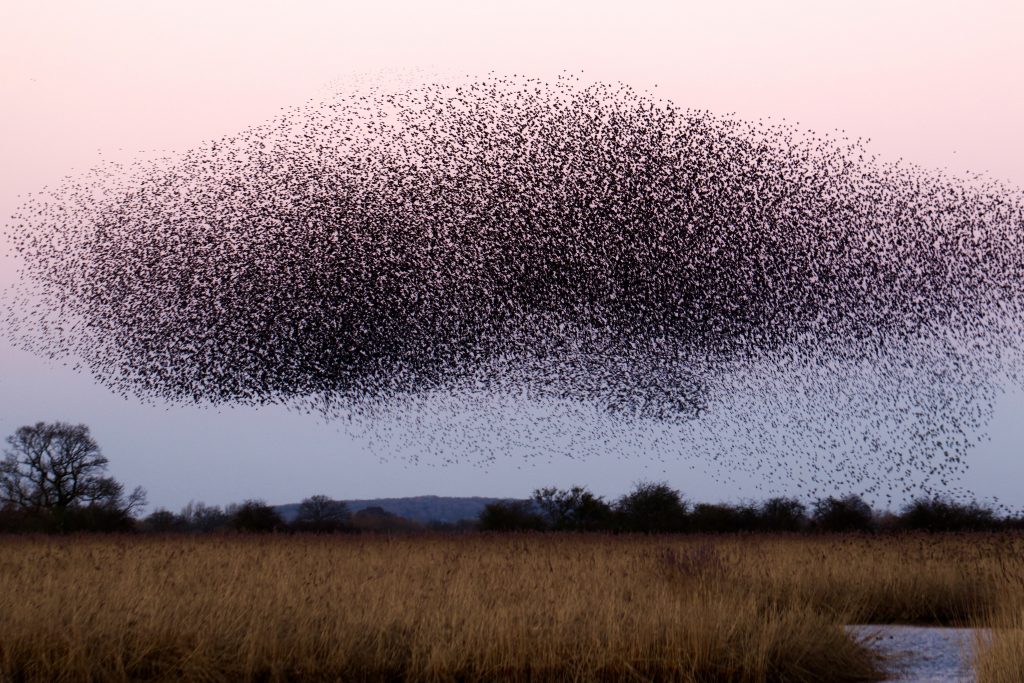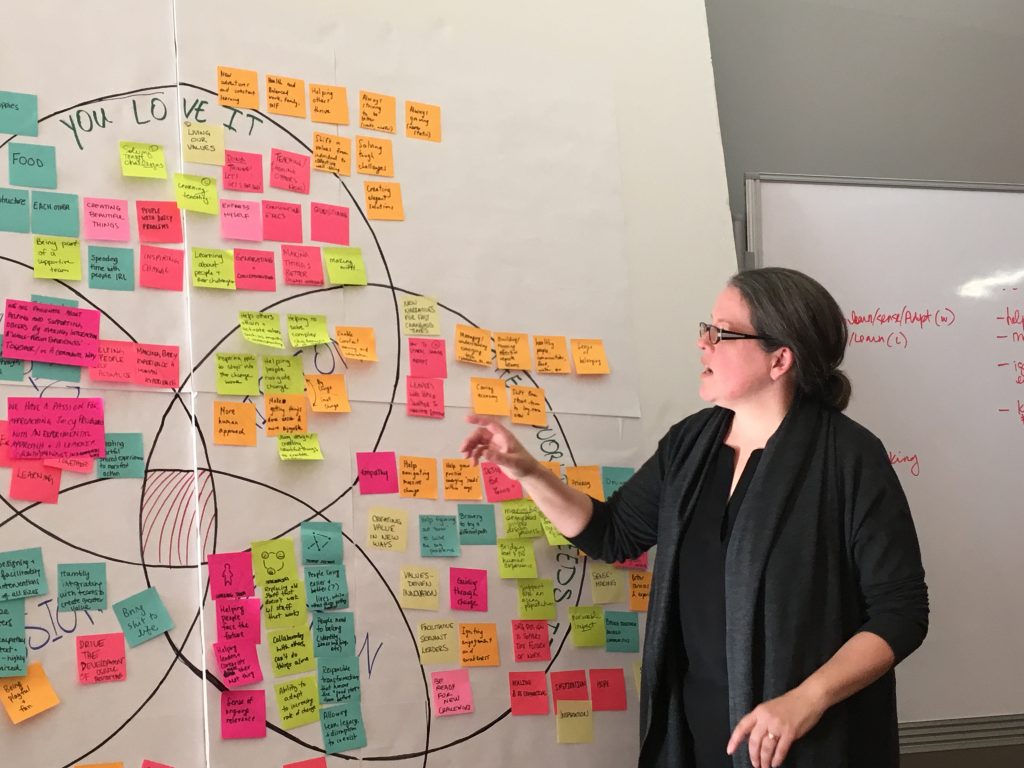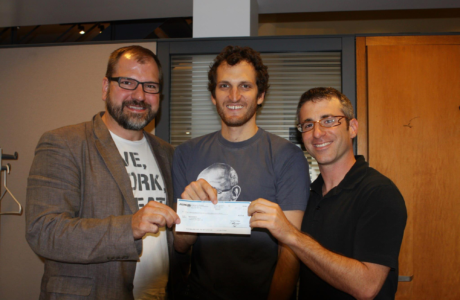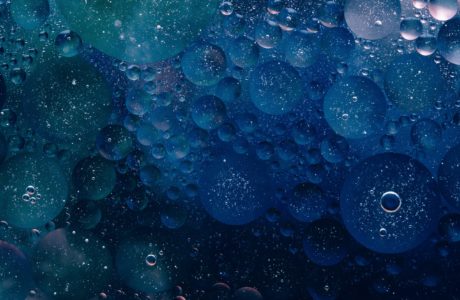An inside look at The Moment's journey to unlock the full potential of self-management.
The Moment is on a journey to unlock the full potential of self-management. “Going Teal” was a key milestone. We believe in honesty, transparency, organizational development, and applying the innovation process to ourselves. The following is a look at why we embrace these values, and how we’re growing as a result.
First, let’s talk about ego.
In his book Advice Not Given, Dr. Mark Epstein says, “Our ego is at once our biggest obstacle and our greatest hope.” Ego is the device or lens through which one experiences the world around oneself. Ego collects the sensory inputs from one’s body, surroundings, and physical needs. Consciousness has often been referred to as one’s higher self. Consciousness knows no limits or boundaries. With the proper perspective, both ego and consciousness can work together to form a happy union.
Teal requires people to access the next level of consciousness. From a developmental perspective, Teal is presented as a breakthrough, the ability to reach a higher vantage point from which one sees the world in a broader perspective. From that perspective, one is able to replace fear, triggered by ego, with the capacity to trust others and the abundance of life.
This notion sparks controversy. It is important to highlight that Laloux, the author of Reinventing Organizations, doesn’t mean that Teal organizations or in this case Teal people are “better” than others, but rather, by engaging with Teal concepts and practices, one can better cope with complexity from a more grounded and aware place.
Here is a passage to illustrate Laloux’s point:
“Let’s first get one potential misunderstanding out of the way: the notion, which makes some people uneasy, that successive stages in development would imply that some people are somehow better than others. It’s a valid concern. As a human race, we have done much harm to each other by means of colonialism, slavery, racism, and sexism, in the name of one group being ‘better’ than other groups.
Human consciousness evolves in successive stages; there is no wishing away the massive amount of evidence that backs this reality. The problem is not with the reality of the stages; it is with how we view the staircase. We get into trouble when we believe that later stages are “better” than earlier stages; a more helpful interpretation is that they are ‘more complex’ ways of dealing with the world. For instance, a person operating from Pluralistic-Green can integrate people’s conflicting perspectives in a way that a person operating from Impulsive-Red most likely cannot. At the same time, every level has its own lights and shadows, its healthy and unhealthy expressions. Orange modernity, for instance, has harmed the planet in a way previous stages never could.”
And I agree with Laloux that there is a real shift here. As humans we are wired with impulses to control, protect, and defend. We are inherently programmed to meet others in judgment, believing that we must be right and they must be wrong. But it’s equally as true that we’re set up to grow psychologically, to evolve, and to develop.
With the evolutionary Teal, people are invited to embrace their wholeness and humanity
Let’s talk about Emotional Intelligence.
In this Youtube video Daniel Goleman talks about the needs of any top performing professional: aside from a high IQ, people need to be self-motivated, self-aware, and emotionally intelligent. Goleman focuses on the importance of aligning one’s motivation to improve with a sense of purpose.
Using a collaborative mindset we can seek to understand and empathize with others in order to harmonize interests. The underlying assumption here is that collaborators are coming in with similar values and and a shared purpose.
The ability to listen deeply, is a vital condition through which we may engage in critical conversations with empathy. The ability to sense others’ emotions, acknowledge their needs, celebrate their gifts, recognize both their strength and weaknesses, and understand their perspective builds trust and leads to a state of flow.
Flow is an ideal state of an organization behaving harmoniously as its highest self. A state in which the organization is acting as a collective, able to respond and act on changes in its environment. As we reflect on “environment”, we realize that nature has many lessons to teach us. We have all seen flocks of birds wheeling and swooping in a choreographed unison. This phenomenon is called flocking. It’s fascinating because birds in flock don’t just follow a leader or a neighbour. Instead, they collectively anticipate and respond to sudden changes in the flock’s direction of motion. Because of this phenomenon birds fly further with less energy, have better chances to protect themselves from predators, and are more responsive to their environment and less dependent on their leader.

As designers we may be predisposed to have a high Emotional Intelligence. We learn to understand and experience the feelings of others through a multitude of tools. We engage users in the creation process using methods like Human-Centered Design. While it may seem simple to transfer these principles to organization design, it is often challenging when we are the subject of our own creation.
The Moment’s unique shade of Teal.
A year ago, I published Fifty Shades of Teal: Why Teal is not for the faint of heart. It was my first reflection piece on The Moment’s journey to embrace the concept of a Teal Organization. Since publishing in the fall of 2017, The Moment team has grown and learned a lot, including my own personal ability to grow with, and help design, a transitioning management structure.
The concept of ‘going Teal’ is a journey; there is no standard blueprint to transform the organization. Rather, Teal is the much-needed provocation for organizations to recognize patterns and behaviours – some of which may be holding them back. It’s an invitation to evolve collaboration and work. It’s a step into a more human organization where people come first.
Now, I celebrate the story of a resilient team committed to not only pursuing our purpose as an organization, but also to embracing change and continuously pushing our boundaries through experimentation and what we call learn-by-doing. I celebrate the story of an organization that, intentionally and organically, fosters a culture of personal and group development and constantly enables its people to overcome their limitations, uncover their blind spots, and improve their mastery of innovation design in an increasingly challenging, complex, and volatile world.
At The Moment, we learn, reflect, grow, and thrive — and our Tealness has been a catalyzer of this.
At The Moment, we learn, reflect, grow, and thrive — and our Tealness has been a catalyzer of this.
Over the last couple of years, The Moment has made a leap into pursuing its purpose in a bold way. What started as a dream with the co-founders – building a purposeful and human business and making positive change in the world – quickly gained traction by attracting practitioners with similar values and determination. It sparked great conversation within the community and amongst leaders in various industries.
As the world changed and interest in innovation skyrocketed, we knew it was time to get clear — about our purpose, and about our intended impact in the world of business and the world at large.
To successfully bring our purpose to life, we needed to enable Momenteers to thrive both individually and as a team. We created an organization that continues to respect our human needs and enables us to access the next level of development. Our evolution continues to be supported by our organization design – one steeped in Teal.
It may come as no surprise that my next statement is this: “change is hard.” Despite the difficulties that change presents, this is a core belief at The Moment. Adaptive and responsive organizations are better positioned to deliver on the purpose they are meant to serve.
By embracing our own change, The Moment took on redesigning everything from business roles, responsibilities, and accountabilities, to a new compensation model and hiring process. We are also revisiting our brand’s core values and messaging, and we’re investing time and effort in crafting our purpose statement.
Few critical factors came into play amidst all of this change. Organization challenges like these, especially when approached with full transparency, can make or break an organization. All that being said, we have lived to tell the (Teal) tale! I have captured a few reflections to share.

Karen Oikonen presents The Moment’s “ikigai” map
Getting real with Teal.
Over the past year we have invested, and continue to invest, a lot of time in hosting conversations, checking in on how we are as humans, and where we are on our individual journeys. We have established structures and behaviours that allow us to bring the whole person to work and to show up as a whole being at the workplace. Here are some of the rituals in place at The Moment that help bring our Teal culture to life:
- We start every week with “Monday Launch”, a full team meeting where we sit together, check in as humans and discuss important issues that implicate the whole team.
- Every 4 months, we spend 2-5 working days to revisit our strategy and focus on internal work. We engage the team to align on our goals and build our internal structures.
- We also make a habit of eating lunch together on a daily basis. While it doesn’t always happen, it’s a ritual that most of us cherish and look forward to!
This time investment is considerable. An organization committing to this kind of transformation better be ready to embrace the cost associated with creating spaciousness for its team members to connect as individuals and reflect on their practices and learnings. An individual participating in this work better be ready to learn humility, show vulnerability, and listen deeply.
As we discuss our needs as individuals, and as a team and a business, ego and self-awareness continue to play a major role in facilitating and disrupting how we engage in challenging debates.
Change inevitably brings feelings of uncertainty. Sensing an unclear future is enough to create stress and sometimes leads to a feeling of a loss of control. Some people are more resistant to change than others.
However, when we anchor conversations in the core values of Teal, and remain true to the purpose we set out to fulfill, it helps increase our risk tolerance, optimism, and sense of self-actualization, among other factors. We feel strongly in supporting the team in their journey by providing wellness benefits like Liminal Thinking, yoga studio memberships, and other services to help create a safety net and a means for coping with the demanding nature of change. Navigating uncertainty is a non-stop quest to tame the ego, concentrate on positive signs, and resist the impulses that set us off.
As The Moment grew, so too did the level of our organizational complexity. We have experienced moments of flocking but as new birds joined the flight, the dance needed to be re-choreographed. Everyday, new questions are raised, and context is changing both within and outside of The Moment. For example, At The Moment, we believe that every time a new Momenteer joins us, we form a new team. In fact, every new team member brings an opportunity to improve and sparks the need to get crisper about our practices, rituals, and values to navigate self-management and the complexity of the systems around them.
Teal is about embracing change. Change is about embracing evolution.
So what’s the first step to building a Teal organization? Embrace change as a constant.
Tackling challenges requires an ample level of resilience and an adaptive mindset to rise above the constant fatigue generated by change. Teal organizations may be better equipped to support their employees and to unlock that next stage of resilience across the team.
Most leading organizations invest in providing some of their people opportunities to grow, through professional development opportunities and leadership training, which eventually enable them to take a seat behind the steering wheel. In a self-managing system the organization must commit to nurturing a culture of continuous development and learning. In order to work as a management structure and unlock the benefits associated with going Teal, the organization and culture must be supported by opportunities and a desire to grow.
“The most exciting breakthroughs of the twenty-first century will not occur because of technology, but because of an expanding concept of what it means to be human.”
– John Naisbitt
We’re continuing to experiment with, and re-design how, Teal shows up in our organization. From the early stages of bringing in actionable ideas, to navigating and redesigning the next stage of Teal, I’ve learned a few things. Any organization that embraces change and transitions to a new system of management faces the complex reality of its personal history, unique journey and composition of people and behaviours.
There’s no point in romanticising the concept of Teal in its absolute state. To become “purely Teal” may be a necessary goal to jumpstart the transformation journey – but when an organization engages with the reality of change it quickly reveals that it may be impossible or not sufficient to become “just” Teal. Being Teal is highly dependent on the willingness and pace of its people to engage, grow their practice, and access its evolved state of consciousness.
With a curious mindset, the next steps become possible: begin an open exploration into the next stage of the evolutionary journey of self-management. Building on the core values of Teal might just equip you with the mindset and abilities to overcome challenges and nurture team resiliency.
Stay tuned for Part III of this series taking a look at the evolution of self-management practices inside The Moment: From Teal to “Holacracy.” We would love to hear your thoughts! Get in touch or read more about how we can partner together: Seeking Allies in Purposeful Innovation.








